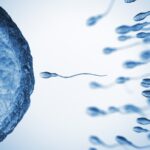A growing numbers of young men take performance and image enhancing drugs, but until now, scientists were unclear how it affected their chances of reproducing.
Anabolic steroids may severely, and even permanently, impair testosterone production and fertility, new research suggests.
One unanticipated consequence of the ‘hidden epidemic’ of performance and image-enhancing drug use is that more couples may go on to face fertility issues as a result.
Around one in 30 Australian high school boys have used anabolic-androgenic steroids, and research suggests their use in the wider population has been increasing over the last two decades.
While androgen abuse is known to completely suppress the production of gonadotropin and endogenous testosterone, specifics of their side effects are largely unknown.
Lead author Dr Diederik Smit, of Spaarne Gasthuis hospital in the Netherlands, studied the semen and hormones of 100 amateur athletes prior to, during, and up to one year after a cycle of steroids.
Steroid users typically use the androgens in a cycle of six to 18 weeks, often followed by a break in which they may use unproven therapies such as tamoxifen, clomiphene citrate and/or hCG in an attempt to return their hormones to normal faster.
Almost all of the participants engaged in some strength sport, and the most commonly used androgens were testosterone (96%), trenbolone (53%) and drostanolone (39%) – although product labels are often unreliable.
Even though only men who hadn’t used androgens in the three months prior to the beginning of the study were allowed to participate, 37 participants had low total testosterone concentration or a total sperm count of less than 40 million at baseline, suggesting they already had gonadal dysfunction. These individuals were more likely to have previously used androgens in higher doses and for longer than those with normal baseline measures.
The researchers gave no input on how to cycle, nor did they prescribe the drugs. The cycles were highly varied among the men, but they all included “very high” doses of androgens that exceeded the normal levels found in the body.
“Irrespective of androgen dose and duration of use, androgen exposure resulted in complete suppression of the hypothalamic-pituitary-gonadal axis, as demonstrated by undetectable luteinizing hormone (LH) and follicle-stimulating hormone (FSH) concentrations in nearly all subjects,” the authors found. “Furthermore, testicular volume declined during androgen abuse and spermatogenesis decreased, with two-thirds of subjects having oligo- or azoospermia by the end of the cycle.”
Almost all of the men had testosterone concentrations return to normal three months after the end of the cycle, and 100% by 12 months, providing they had normal gonadal function at the beginning of the study.
Of the 37 men who had abnormal measures at the beginning of the study, nine continued to have low total testosterone at the end of the follow-up.
“Whereas testosterone levels come up after discontinuing androgen abuse in most cases, we have evidence to believe that cumulative exposure to androgens reduces the chance of recovery,” Dr Smit told TMR.
“This may especially be the case for athletes abusing androgens for a long time or in a non-stop fashion (blast and cruise),” he said. “In our clinic we deal with athletes who have a permanent hypogonadism after anabolic androgenic steroids use on a daily basis.”
Recovery of sperm levels also took longer in those with abnormal gonadal function at baseline – up to 69 weeks for some men, compared to an average of 47-56 weeks in those with normal baseline measures.
“As for fertility, recovery is slow and most users have started a new cycle before spermatogenesis has normalized,” said Dr Smit. “Being unaware of this complication, athletes may stumble upon difficulties to achieve pregnancy later in life.”
“Stopping androgens, being patient and awaiting recovery will reward most. But ideally, androgens should be stopped for at least one year before the wish to have children is at hand.”
In a recent paper, Dr Smit provided advice to clinicians managing patients who take anabolic steroids. For past users, he recommended taking a careful history, which included information on the number, length and dose of steroid cycles. These patients should also be routinely checked for signs of gonadal dysfunction, such as cryptorchidism, gynaecomastia and infertility, as well as other recreational drug use.
More guidance for Australian GPs on managing patients who currently steroid use can be found here.





